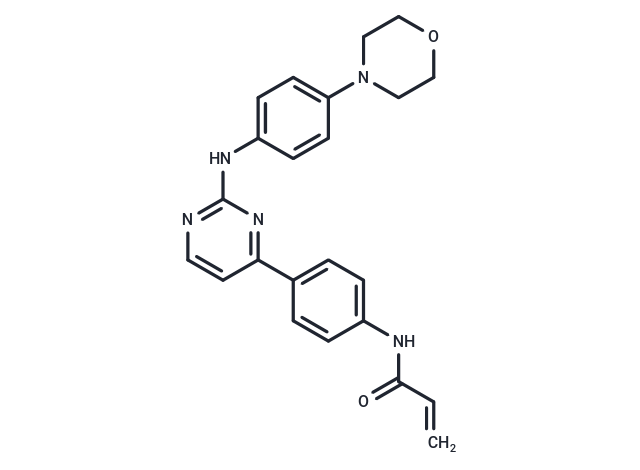Shopping Cart
Remove All Your shopping cart is currently empty
Your shopping cart is currently empty
JAK3-IN-11 (Compound 12) exhibits potent, noncytotoxic, irreversible, orally active JAK3 inhibitory activity (IC50 = 1.7 nM) with an excellent selectivity profile (>588-fold compared to other JAK isoforms), covalently binds to the ATP-binding pocket in JAK3. JAK3-IN-11 strongly inhibits JAK3-dependent signaling and T-cell proliferation which is a promising tool for studying autoimmune diseases [1].

| Pack Size | Price | USA Warehouse | Global Warehouse | Quantity |
|---|---|---|---|---|
| 25 mg | $1,520 | 10-14 weeks | 10-14 weeks | |
| 50 mg | $1,980 | 10-14 weeks | 10-14 weeks | |
| 100 mg | $2,500 | 10-14 weeks | 10-14 weeks |
| Description | JAK3-IN-11 (Compound 12) exhibits potent, noncytotoxic, irreversible, orally active JAK3 inhibitory activity (IC50 = 1.7 nM) with an excellent selectivity profile (>588-fold compared to other JAK isoforms), covalently binds to the ATP-binding pocket in JAK3. JAK3-IN-11 strongly inhibits JAK3-dependent signaling and T-cell proliferation which is a promising tool for studying autoimmune diseases [1]. |
| Targets&IC50 | JAK2:1 μM, JAK3:1.7 nM, JAK1:1.32 μM |
| In vitro | JAK3-IN-11 (Compound 12) exhibits strong immunosuppressive activity by selectively inhibiting JAK3, without significant cytotoxic effects at 10 μM over 72 hours. It suppresses T cell proliferation with IC50 values of 0.83 μM and 0.77 μM under anti-CD3/CD28 and IL-2 stimulation, respectively, and inhibits IL-2 or IL-15-induced STAT5 phosphorylation within 1 hour in a dose-dependent manner (0-10 μM). The compound covalently and irreversibly binds to JAK3, with effectiveness confirmed by cell proliferation assays using mouse T cells and Western blot analysis for phosphorylation status, indicating modulation of relevant immune pathways. |
| In vivo | JAK3-IN-11 (Compound 12) effectively inhibits oxazolone (OXZ)-induced delayed-type hypersensitivity (DTH) in Balb/c mice in a dose-dependent manner when administered orally at doses of 0-30 mg/kg over a 6-day challenge phase, with 3, 10, and 30 mg/kg doses reducing DTH responses. In male ICR mice, preliminary pharmacokinetic analysis following oral gavage and intravenous administration at 30 mg/kg and 10 mg/kg, respectively, measured parameters such as AUC(0-t), AUC(0-∞), MRT, Vz, CLz, t 1/2, C max, and bioavailability, providing insights into the compound's pharmacokinetics. |
| Molecular Weight | 401.46 |
| Formula | C23H23N5O2 |
| Cas No. | 2412734-00-8 |
| Relative Density. | 1.273 g/cm3 (Predicted) |
| Storage | Powder: -20°C for 3 years | In solvent: -80°C for 1 year | Shipping with blue ice/Shipping at ambient temperature. |
| Size | Quantity | Unit Price | Amount | Operation |
|---|

Copyright © 2015-2025 TargetMol Chemicals Inc. All Rights Reserved.